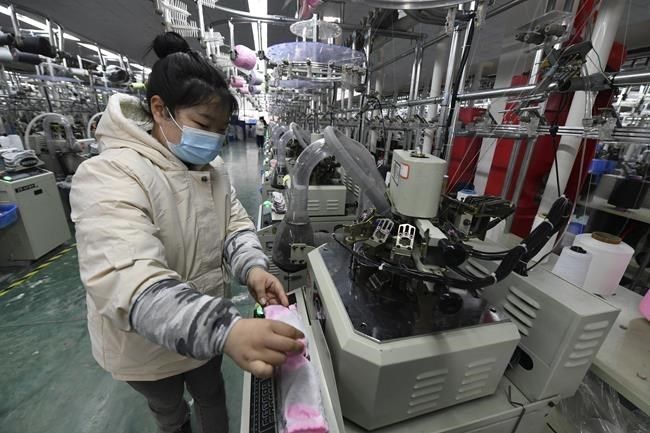BEIJING (AP) — China’s economy contracted in the three months ending in June compared with the previous quarter after Shanghai and other cities shut down to fight coronavirus outbreaks, but the government said a “stable recovery” is under way after businesses reopened.
The world’s second-largest economy shrank by 2.6%, down from the January-March period's already weak 1.4%, official data showed Friday. Compared with a year earlier, a measures that can hide recent fluctuations, growth slid to 0.4% from the earlier quarter’s 4.8%.
Activity was “much weaker than expected,” Rajiv Biswas of S&P Global Market Intelligence said in a report.
Asian stock markets were mixed following the news. The Hong Kong was down 0.8% at mid-morning while Shanghai, Tokyo and Seoul gained.
Anti-virus controls shut down Shanghai, site of the world’s busiest port, and other industrial centers starting in late March, fueling concerns global trade and manufacturing might be disrupted. Millions of families were confined to their homes, depressing consumer spending.
Factories and offices were allowed to start reopening in May, but economists say it will be weeks or months before activity is back to normal. Economists and business groups say China’s trading partners will feel the impact of shipping disruptions over the next few months.
“The resurgence of the pandemic was effectively contained,” the statistics bureau said in a statement. “The national economy registered a stable recovery.”
Data on factory output, consumer spending and other activity suggest overall growth was even weaker than the headline figure, Julian Evans-Pritchard of Capital Economics said in a report.
“Even accounting for June’s strength, the data are consistent with negative y/y (year-on-year) growth last quarter,” Evans-Pritchard wrote. “This isn’t the first time that the official GDP figures have seemingly understated the extent of an economic downturn.”
The slump hurts China’s trading partners by depressing demand for imported oil, food and consumer goods.
China’s infection numbers are relatively low, but Beijing responded to its biggest outbreak since the 2020 start of the pandemic with a “zero-COVID” policy that aims to isolate every person who tests positive. The ruling party has switched to quarantining individual buildings or neighborhoods with infections but those restrictions covered areas with millions of people.
The ruling Communist Party is promising tax refunds, free rent and other aid to get companies back on their feet, but most forecasters expect China to fail to hit the ruling party’s 5.5% growth target this year.
Other major economies report growth compared with the previous quarter, which makes their levels look lower than China. Beijing for decades reported only growth compared with the previous year, which hit short-term fluctuations, but has started to release quarter-on-quarter figures.
Forecasters say Beijing is using cautious, targeted stimulus instead of across-the-board spending, a strategy that will take longer to show results. Chinese leaders worry too much spending might push up politically sensitive housing costs or corporate debt they worry is dangerously high.
Growth for the first half of the year was 2.5% over a year earlier, one of the weakest levels in the past three decades.
Retails sales were off 0.7% from a year earlier in the first half after plunging 11% in April.
Investment in factories, real estate and other fixed assets climbed 6.1%, reflecting the ruling party’s effort to stimulate growth by boosting spending on public works construction and ordering state-owned companies to spend more.
China also faces headwinds from weak global demand. Exports jumped 17.9% in June over a year earlier, but forecasters say that reflected ports clearing out cargo after anti-virus curbs lifted. They say growth is likely to fall back.
Slowing growth in the United States and Europe “could weaken demand for China’s manufacturing exports,” said Biswas.
China rebounded quickly from the pandemic in 2020, but activity weakened as the government tightened controls on use of debt by its vast real estate industry, which supports millions of jobs. Economic growth slid due to a slump in construction and housing sales.
Investors are waiting to see what happens to one of China’s biggest developers, Evergrande Group. It has struggled since last year to avoid defaulting on $310 billion owed to banks and bondholders.
Joe Mcdonald, The Associated Press



